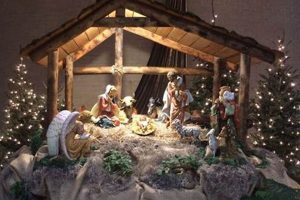The construction of elevated surfaces intended for exhibiting miniature holiday scenes, frequently incorporating self-made components, is a common practice. These structures serve as bases for arranging collectible figurines, miniature buildings, and landscape features, creating a multi-dimensional presentation. For example, builders use foam board, wood, or recycled materials to create tiered platforms, adding visual interest and spatial organization to the arrangement.
Elevating these miniature landscapes provides enhanced visibility and facilitates more intricate scene composition. The vertical dimension allows for the simulation of varied terrain, such as hills and valleys, increasing the realism and aesthetic appeal of the display. Historically, showcasing miniature Christmas villages has evolved from simple tabletop arrangements to elaborate, multi-level constructions, reflecting advancements in crafting techniques and design sensibilities.
The following sections will detail materials selection, construction methods, and design considerations for achieving visually compelling and structurally sound elevated displays. These considerations are vital for creating a captivating holiday centerpiece.
Tips for Constructing Elevated Miniature Holiday Scene Platforms
The following guidelines offer practical advice for building structurally sound and visually appealing bases for miniature holiday scene arrangements.
Tip 1: Material Selection: Opt for rigid materials, such as high-density foam board or plywood, to ensure a stable foundation. Avoid flexible or easily compressible materials that may warp or deform under the weight of the displayed items.
Tip 2: Structural Integrity: Reinforce elevated sections with internal supports. Utilize wood bracing or additional layers of rigid foam to prevent sagging and maintain a level surface, particularly for larger or heavier arrangements.
Tip 3: Scalability and Modularity: Design platforms in modular sections that can be reconfigured or expanded upon in subsequent years. This allows for flexibility in layout and accommodation of new acquisitions.
Tip 4: Surface Texture and Detailing: Apply textured coatings or scenic materials to the platform surfaces to simulate realistic terrain. Consider using flocking, artificial snow, or sculpted foam to create varied landscapes.
Tip 5: Concealing Cords and Wiring: Integrate channels or tunnels within the platform structure to conceal electrical cords and wiring for illuminated elements. This maintains a clean aesthetic and prevents tripping hazards.
Tip 6: Secure Attachment: Employ adhesive or mechanical fasteners to secure miniature buildings and figurines to the platform. This prevents accidental displacement or damage, particularly in high-traffic areas.
Tip 7: Weight Distribution: Distribute the weight of the displayed items evenly across the platform surface. Avoid concentrating heavy objects in one area to prevent structural stress and potential collapse.
These tips facilitate the creation of durable, visually appealing, and safe displays. Applying these principles ensures the longevity and aesthetic quality of the miniature holiday scene platform.
The subsequent section will address specific design techniques to enhance the visual impact of the display.
1. Material Durability
The longevity of a Christmas village display platform is directly contingent upon the durability of the construction materials. The selected material must withstand the cumulative weight of the miniature structures, figurines, and scenic elements placed upon it. Inadequate material strength results in structural failure, potentially damaging the display components. For example, using lightweight cardboard may initially seem cost-effective; however, its susceptibility to moisture and inability to support significant weight inevitably leads to warping or collapse, necessitating costly repairs or reconstruction.
Conversely, opting for materials such as plywood or high-density foam board significantly enhances the platform’s lifespan. Plywood offers a robust, stable surface resistant to bending and deformation, even under prolonged stress. High-density foam board provides a lightweight yet rigid alternative, suitable for multi-tiered designs and intricate landscaping features. These materials also exhibit greater resistance to environmental factors, such as humidity and temperature fluctuations, further preserving the integrity of the Christmas village display.
In conclusion, prioritizing material durability is not merely an aesthetic consideration but a practical imperative for anyone undertaking Christmas village display platform construction. The investment in robust materials directly translates to a more stable, long-lasting display, minimizing the risk of damage and ensuring the continued enjoyment of the miniature holiday village for years to come.
2. Structural Support
Structural support is a critical determinant of the stability and longevity of miniature holiday scene displays. A properly supported base ensures that the weight of the miniature buildings, figurines, and associated decorations is evenly distributed, preventing sagging, warping, or catastrophic collapse. The absence of adequate support compromises the aesthetic presentation and potentially endangers the valuable collection displayed upon it.
- Internal Bracing
Internal bracing involves the incorporation of reinforcing elements within the platform structure. These may include wooden ribs, foam board supports, or metal struts strategically positioned to counteract stress points. For instance, a large, multi-tiered platform constructed from foam board benefits from internal wood bracing to prevent sagging in the middle tiers. The placement and density of internal bracing directly influence the load-bearing capacity and overall rigidity of the platform.
- Foundation Stability
The foundation upon which the display rests is equally important. A level, stable surface prevents uneven weight distribution, which can lead to localized stress concentrations and eventual structural failure. Uneven flooring necessitates the use of leveling shims or adjustable feet to ensure a consistent load distribution across the entire platform base. A robust foundation provides a stable anchor for the entire display, minimizing the risk of accidental tipping or shifting.
- Material Selection Impact
The choice of construction materials significantly influences the structural support requirements. Denser, more rigid materials, such as plywood or high-density foam, inherently possess greater load-bearing capacity than less substantial options like cardboard or thin foam sheets. A platform constructed from plywood requires less internal bracing than an equivalent structure built from foam board. Material selection must align with the anticipated weight load and the desired aesthetic characteristics of the display.
- Joint Reinforcement
The points where different platform components connect are critical areas for structural reinforcement. Weak joints can become points of failure under stress. Methods for reinforcing joints include using wood glue, screws, nails, or metal brackets to create strong, durable connections. For example, corners of foam board platforms can be reinforced with angled metal brackets to prevent separation and maintain structural integrity.
The effective implementation of structural support principles is paramount for creating a durable and visually appealing Christmas village display. Neglecting these considerations can result in premature degradation of the platform and potential damage to the miniature collection. A well-engineered and constructed platform not only enhances the aesthetic presentation but also ensures the long-term preservation of the cherished holiday display.
3. Tiered Layout
Tiered layouts are a prevalent design element in miniature holiday village displays, optimizing visual interest and spatial utilization within the constraints of available display area. The implementation of varying vertical levels allows for a more dynamic and realistic representation of a miniature landscape, enhancing the overall aesthetic appeal of the display.
- Perspective Enhancement
Tiered arrangements create an illusion of depth, drawing the viewer’s eye across multiple planes and generating a more immersive experience. Buildings positioned on higher tiers appear further away, mimicking the natural perspective found in real-world landscapes. For instance, placing a miniature church on an elevated platform visually recedes it into the background, enhancing the perceived scale of the village. This method is a strategic technique to create expansive vistas within a limited space.
- Zonal Organization
Vertical stratification facilitates the clear delineation of distinct zones within the Christmas village. Separate tiers can represent different areas, such as a residential neighborhood, a commercial district, or a mountainous region. This segregation simplifies visual interpretation and allows for the thematic organization of miniature structures and figurines. An example includes positioning a ski resort on a higher tier to represent a mountainous area, separate from the village center situated on a lower level.
- Visibility Optimization
A tiered layout ensures that all elements of the miniature village are visible, preventing larger structures from obscuring smaller details. By elevating certain buildings, the viewer’s line of sight remains unobstructed, allowing them to appreciate the intricacies of each miniature component. Raising smaller shops or figurines on platforms ensures they are not lost amidst larger buildings, maintaining a balanced and comprehensive display.
- Landscape Integration
Tiered platforms provide a foundation for integrating landscape features, such as hills, valleys, and rivers, into the miniature village. These vertical variations create a more realistic and engaging environment for the miniature structures and figurines. The elevation differences can be utilized to simulate rolling terrain, adding visual interest and authenticity to the overall presentation. The use of foam board to construct varying elevations for creating rolling hills can greatly enhance the overall realism.
In summary, the strategic employment of tiered layouts within miniature holiday village displays contributes significantly to improved visual depth, enhanced organizational clarity, optimized visibility, and seamless landscape integration. These factors collectively enhance the overall appeal and realism of the Christmas village, transforming it from a simple collection of miniatures into a captivating miniature world.
4. Scenic Integration
Scenic integration, in the context of elevated miniature holiday scene surfaces produced through do-it-yourself methods, involves the seamless blending of structural elements with artistic landscaping to create a cohesive and immersive environment. This process extends beyond merely placing miniature buildings on a platform; it necessitates the creation of a realistic and visually appealing backdrop that complements and enhances the overall presentation.
- Terrain Modeling
Terrain modeling refers to the construction of realistic ground features using various materials. This includes simulating hills, valleys, and flatlands through sculpted foam, stacked cardboard, or layered fabrics. A successful application of terrain modeling ensures that the platform surface is not merely a flat plane but a three-dimensional landscape that mimics natural environments. For instance, incorporating a gentle slope leading up to a miniature ski resort enhances the realism of the scene and provides a more natural setting for the miniature buildings.
- Material Selection for Realism
The choice of materials directly impacts the believability of the miniature landscape. Artificial snow, flocking, textured paints, and miniature vegetation contribute to the illusion of a realistic environment. The strategic use of these materials can transform a simple platform into a visually compelling representation of a winter wonderland. Employing different textures and colors to simulate various terrain types, such as rocky outcrops or frozen lakes, further enhances the immersive quality of the display.
- Lighting Effects
Illumination plays a crucial role in scenic integration, enhancing the visual impact of the miniature landscape. Strategically placed LED lights can simulate moonlight, streetlights, or festive holiday lighting, adding depth and ambiance to the scene. The use of fiber optics to create twinkling stars or small spotlights to highlight specific features further contributes to the immersive effect. Careful consideration of color temperature and light intensity ensures that the lighting complements the overall aesthetic and enhances the realism of the display.
- Seamless Transitions
Effective scenic integration requires seamless transitions between different landscape elements and the platform itself. This involves blending edges, concealing seams, and creating a cohesive visual flow throughout the display. Utilizing techniques such as applying a thin layer of textured paint or flocking over the entire surface can help to unify disparate elements and create a more harmonious composition. Attention to detail in these transitions is essential for achieving a polished and professional-looking result.
These facets collectively contribute to the successful incorporation of scenic elements into elevated miniature holiday scene surfaces. By prioritizing realistic terrain modeling, thoughtful material selection, strategic lighting effects, and seamless transitions, creators can elevate the aesthetic quality of their displays and transform them into captivating miniature worlds. These integrated aspects are critical to the overall presentation and the ability to create an immersive experience.
5. Space Optimization
Space optimization is a fundamental consideration in the creation of elevated surfaces for miniature holiday scene arrangements. Due to the inherently limited area available in many residences, the ability to maximize display space becomes paramount. Without effective space management strategies, the potential scope and complexity of the miniature village are significantly curtailed. The creation of elevated platforms directly addresses this limitation by utilizing vertical space, enabling the inclusion of more structures and features within a given footprint. For instance, a multi-tiered platform allows for the layering of village components, effectively doubling or tripling the display area compared to a single-level surface.
Further techniques for spatial efficiency include the incorporation of irregular shapes and custom-fitted designs. Rather than adhering to a standard rectangular platform, builders may tailor the structure to fit into corners, alcoves, or along walls, thereby utilizing otherwise unusable areas. Additionally, platforms can be designed with integrated storage compartments beneath the display surface, providing a practical solution for storing miniature components when not in use. The utilization of modular platform sections also contributes to optimization, as they can be rearranged or reconfigured to accommodate varying spatial constraints or expanding collections. Consider examples of DIY platforms designed to fit around existing furniture, maximizing the available space within a living room.
In conclusion, space optimization is not merely an ancillary concern but a core principle that dictates the feasibility and impact of miniature holiday scene displays. The creation of elevated platforms is an effective response to spatial limitations, enabling the realization of intricate and comprehensive village arrangements. Overcoming spatial challenges ensures that even in constrained environments, elaborate and visually captivating holiday displays can be achieved, offering a more immersive and enjoyable experience. This understanding has practical significance, allowing enthusiasts to create extensive displays regardless of living space size.
Frequently Asked Questions
The following addresses common inquiries regarding the construction and implementation of self-made elevated surfaces for miniature holiday scenes. These answers provide practical guidance for ensuring structural integrity and visual appeal.
Question 1: What is the optimal material for constructing elevated platforms?
Plywood and high-density foam board are generally preferred. Plywood offers superior structural stability for larger displays, while high-density foam board provides a lightweight alternative suitable for multi-tiered designs. Material selection depends on the intended scale and weight load of the display.
Question 2: How can the structural integrity of elevated sections be reinforced?
Internal bracing is essential for preventing sagging and maintaining a level surface. Wood supports or additional layers of rigid foam can be strategically placed beneath elevated sections to distribute weight and enhance stability.
Question 3: Is modular design beneficial for constructing platforms?
Yes. Modular sections offer flexibility in layout and facilitate future expansion or reconfiguration. This approach allows for adapting the display to different spaces and incorporating new additions to the miniature village.
Question 4: How can electrical cords and wiring be concealed within the platform structure?
Incorporating channels or tunnels within the platform’s construction allows for the discreet routing of electrical components. This prevents visible clutter and minimizes potential safety hazards.
Question 5: What methods are effective for securing miniature buildings and figurines to the platform surface?
Adhesive or mechanical fasteners are recommended. Adhesives provide a temporary bond, while screws or nails offer a more permanent solution. The method of attachment should be chosen based on the size and weight of the displayed items.
Question 6: How does the distribution of weight impact the stability of the platform?
Even weight distribution is crucial for preventing structural stress and potential collapse. Concentrating heavy objects in one area should be avoided. Distributing weight evenly across the platform ensures greater stability and minimizes the risk of damage.
These answers offer guidance on construction, materials, and design. Careful attention to these factors ensures the creation of a durable and visually appealing miniature holiday scene display.
The subsequent section will discuss safety considerations when building elevated platforms.
Conclusion
The construction of self-made elevated surfaces for miniature holiday scenes represents a significant undertaking. This exploration has highlighted critical factors, including material selection, structural support, tiered layouts, scenic integration, and space optimization. Each of these elements directly impacts the stability, visual appeal, and overall longevity of the display. Careful consideration of these aspects is essential for achieving a successful outcome.
Therefore, the construction of these surfaces requires thorough planning and execution. The commitment to safety and durability is paramount. Such efforts not only enhance the aesthetic qualities of the miniature holiday scenes but also ensure their enduring presence as a cherished part of holiday traditions, effectively highlighting the intersection of craft and holiday display.







